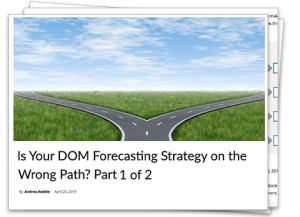Now More Than Ever: Supply Chain Analytics for Demand Forecasting
FORECASTING DEMAND IN A PANDEMIC
 This “oldie but goodie” article we wrote on demand forecasting strategy still applies today, even in the middle of this pandemic.
This “oldie but goodie” article we wrote on demand forecasting strategy still applies today, even in the middle of this pandemic.
The gist: Traditional demand forecasting strategies no longer work because they look at demand where the purchase happens, NOT at the point of fulfillment.
This is especially relevant today when you look at how COVID-19 has forced consumers out of their normal buying routines.
SOME STATS ON ECOMMERCE GROWTH RIGHT NOW
For example, ecommerce is flying, now that being home is the new normal for many people.
Wayfair’s sales growth in March doubled over January and February surging to 37%. In addition, Adobe’s 2020 Digital Economy Index gives us some eye-opening figures on the growth of ecommerce during Coronavirus:
- Digital purchasing power has increased by 20%
- Computers and monitors have seen a 40% increase in average daily sales comparing March 1-10 to March 11-25
- Fitness equipment has seen a 55% increase comparing those same periods
- From January 1-March 11, non-perishables have increased by 87%
- During that same period, virus protection products (gloves, masks, hand sanitizer, etc.) have increased by 807% and over-the-counter cold/flu drugs have increased by 217%
That’s certainly consistent with what we’re hearing from our customers:
- Ecommerce is booming
- Competition is super high, with high price transparency
- Average gross margin is contracting on a 100-point basis
- We need to free up cash, like NOW
SUPPLY CHAIN IS A PINBALL
 Retailers – and hence distributors – have to react to tectonic shifts in how products get fulfilled. This imposes new costs, elusive supply and a host of other uncertainties. Supply chain is a pinball, flinging around aimlessly. It always is, but especially now. Demand forecasting must be just as nimble, and supply chain analytics is the only way to get you there.
Retailers – and hence distributors – have to react to tectonic shifts in how products get fulfilled. This imposes new costs, elusive supply and a host of other uncertainties. Supply chain is a pinball, flinging around aimlessly. It always is, but especially now. Demand forecasting must be just as nimble, and supply chain analytics is the only way to get you there.
Intelligent demand forecasting systems built on machine learning will be crucial to predicting demand tendencies at the most detailed customer transaction level, such as:
- Timing –Who purchased what, at what time of day?
- Location –Which neighborhood or area has clear demand spikes?
- Product Affinity –What co-products are often purchased together?
LEARN MORE
Want to learn more about how to track demand and fulfillment with demand forecasting analytics? Reach out. We’re happy to share our learnings and recommendations.


Comments are closed.